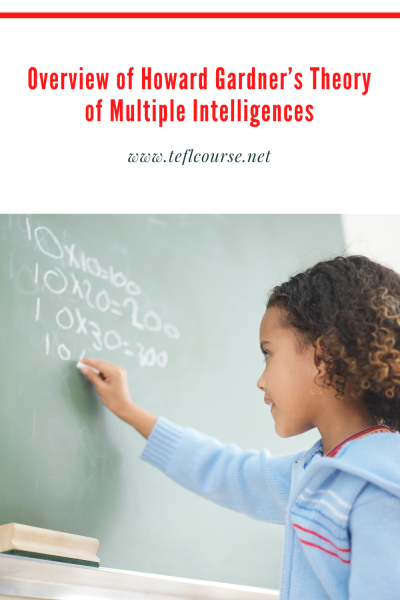Overview of Howard Gardner’s Theory of Multiple Intelligences

The theory of Multiple Intelligences was developed by Howard Gardner. The theory postulates that there are many different types of intelligence, which involve different skills and ways of thinking. Gardner (1989) relied on that intelligence was divided into the following categories: linguistic, logical-mathematical, spatial, bodily-kinesthetic, musical, interpersonal and intrapersonal.
This post was written by our TEFL certification graduate Gina F. Please note that this blog post might not necessarily represent the beliefs or opinions of ITTT.
Linguistic Intelligence
It relates to an individual's ability to use language. This involves the comprehension and production of verbal and written language. Students with linguistic intelligence generally excel in ESL classrooms as they acquire and understand the language easily. Individuals with high linguistic intelligence benefit by reading or listening to concepts. Students with linguistic ability enjoy reading real texts, and more advanced students will be motivated to read novels. They are also motivated by word games (ie- crosswords and parts of speech-bingo). For linguistically intelligent students, with some English, open-ended activities, such as writing different text types (eg- essays, stories, newspaper articles, diary entry) are a good activity as they enable them to draw on their linguistic ability, and are motivating as provide challenge and creativity.
Visual/ spatial intelligence
It relates to an individual’s spatial judgment and reasoning; and their ability to visualize the world with accuracy. Individuals with good visual/ spatial intelligence can remember images, faces, and details and can visualize and create accurate images (Armstrong, 2009). Individuals who have visual/spatial intelligence learn best when provided visual representations rather than through auditory information, and will remember how to spell words by looking rather than phonetically. Teachers should augment what they say with visual cues and written examples. Moreover, written texts should be illustrated, and props and pictures should be used. Activities that involve creating drawings should be utilized. Examples include Pictionary, making posters and comic strips. Graphic organizers (ie Venn diagrams and sequence charts) will help the memorization of concepts and vocabulary (Pesce, n.d. - d).

Also Read: Top 5 Tips for Making Friends While Teaching English Abroad | ITTT | TEFL Blog
Bodily-kinesthetic intelligence
It relates to motor skills and coordination. Individuals with bodily-kinaesthetic intelligence are skilled at controlling the movements of their body and manipulating objects. They process information physically through tactile sensations and movement and are more focused when they are physically active. Consequently, they can find activities that involve sitting still for long periods difficult (Armstrong, 2009). Thus an ESL teacher should provide activities that allow for physical activity. Such activities include role-playing and charades; scavenger hunts, songs with movement; and physical games (eg- a ball game, where the catcher of the ball needs to provide a vocabulary related to a topic) (Pesce, n.d. - c). Craft activities that involve the whole hand and tactile sensations are also good (eg- clay).
Also Read: Two Traveling Teachers Share What It's Like Teaching English Abroad As A Couple
Logical-mathematical intelligence
It relates to logic, reasoning, critical thinking and the ability to understand abstractions and casual relationships. Individuals with logical-mathematical intelligence like to classify, categorize and find patterns ( Armstrong, 2009). Individuals with logical-mathematical learning styles learn best when activities are structured. They prefer sequential step by step activities and obvious goals. Thus the ESL teacher should make the goal explicit especially if it is a more open-ended activity where the goal is less obvious. They can also guide students through the steps of an open-ended activity by providing a step by step demonstration. As they can easily understand patterns, they often access language through the grammatical structures. Teachers need to support this by providing opportunities for students to analyze and self-discover patterns in grammar.
Also Read: "10+ Activities For Teaching English Summer Camp"
Musical intelligence
It refers to an individual’s ability to process and understand music. Individuals with this intelligence can distinguish and understand differences in pitch, tone, rhythm and of different types of sounds. These individuals will then use this knowledge to perform and create music. Individuals with musical intelligence learn songs easily. Thus a good ESL teaching strategy is to teach through songs and provide opportunities for students to create their own songs. Chants are also useful, as they are rhythmic and easy to remember (Pesce, n.d. -b). Rhymes, rhyming activities and games should also be used to support pronunciation and aid memorization (Verner, n.d.). Rhythms can be found within English as sentences are broken up into words, with one word being stressed; and words are broken up into syllables, with one syllable being stressed. Emphasizing this rhythm supports pronunciation. Sentence rhythm can be emphasized by clapping on each word in a sentence and then clapping louder on the stressed word. Word rhythm can be emphasized by clapping on each syllable and then clapping louder on the stressed syllable.

Interpersonal intelligence
It relates to an ability to interact with others. It involves being able to communicate with people, an understanding of emotions and behavior of other people and an ability to empathize and relate to others. Individuals with interpersonal intelligence prefer collaborative learning experiences (Armstrong, 2009). To promote this group students in pairs and groups. Collaborative activities include discussions, brainstorming, interviews, and role-plays. Interpersonal students enjoy teaching others, thus a good activity is for them to teach the class either an English related skill or a general skill (Pesce, n.d - a). As interpersonal intelligent students are good at empathizing another good activity is for them to write or talk about someone else’s perspective (Pesce, n.d. - a).
Also Read: Can I teach English abroad without a work visa?
Intrapersonal intelligence
It refers to a capacity to be self-reflective. An individual with high intrapersonal intelligence can understand their own emotions, motives, and behaviors. They are self-motivated like to set goals and reflect on their learning, and often prefer to work independently. To support intrapersonal learners enable students to set and reflect on English learning goals; and provide them opportunities to direct their own learning by providing choices (Armstrong, 2009). As intrapersonal students are introspective a good activity is reflective journaling.
Do you want to teach English abroad? Take a TEFL course!
It is important to include activities that suit different bits of intelligence so that all students can learn. Teachers can do this by integrating visual, music and movement activities with speaking, listening, writing and reading activities; and by providing opportunities for students to work collaboratively and guide their own learning.
Apply now & get certified to teach english abroad!
Speak with an ITTT advisor today to put together your personal plan for teaching English abroad.
Send us an email or call us toll-free at 1-800-490-0531 to speak with an ITTT advisor today. •
Related Articles:
- Top Online Lesson Plan Resources for New and Advanced Teachers
- Advantages of Teaching Adult Students and Implications on Teacher’s Methodology
- How To Write The Perfect ESL Lesson Plan
- Online or In-Class - Which TEFL Course Should You Take?
- How To Write The Perfect ESL Lesson Plan
- Getting Student Placement Right - The Best Desk Arrangements for EFL Students




